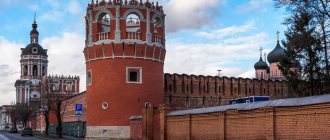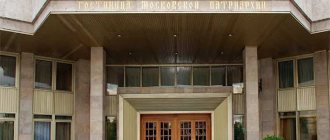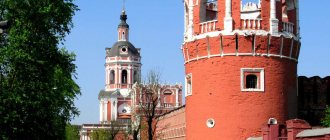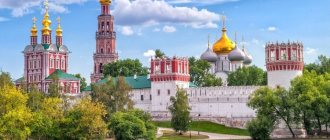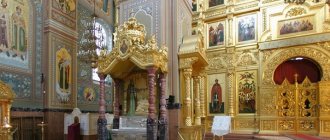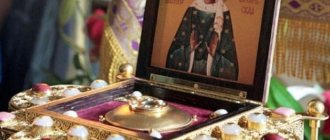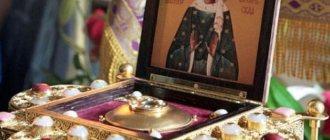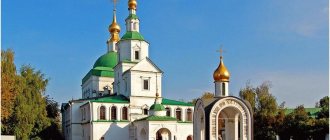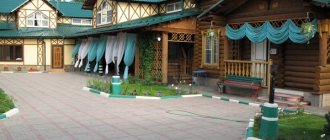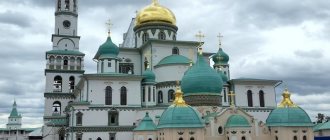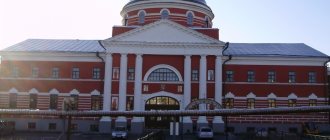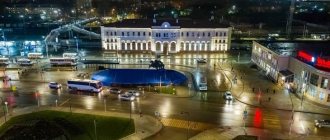The history of our country is often cruel and merciless to historical monuments, especially if they have sacred, spiritual significance. Many churches were destroyed, more than one monastery was razed to the ground, and we can only learn about them from the memories of eyewitnesses. But there are monasteries that were luckier and which history has preserved almost intact for posterity. Among these lucky ones is the Donskoy Monastery , which, although it has gone through many hardships, still survived unbroken, and today hospitably opens its gates to tourists and parishioners.
What is the Donskoy Monastery famous for?
Over its more than 400-year history, it has seen invasions of enemies, attacks by atheists, ruin, closure - and has finally been revived in recent decades.
View of the monastery from the bell tower (1865?
Shrines
This, of course, is the miraculous image to which the monastery owes its very foundation, other revered icons, as well as the relics of the saints of God.
Don icon
This is an honest image of the Mother of God, with which the blgv may have blessed. St. Demetrius Donskoy Sergius of Radonezh when he went to the Battle of Kulikovo. After the battle, the image remained in the Assumption Cathedral of the princely “fatherland”, Kolomna. Around 1393, the famous icon painter, Theophanes the Greek, made a copy of it. Since that time, a tradition has been established to pray in front of the icon for the salvation of the capital when enemies are found.
An image of the icon of the Mother of God of the Don, which was located in the Moscow Donskoy Monastery before the revolution. No later than 1893
This was the case in 1591. When the hordes of the Crimean Khan Kazy-Girai approached the capital, the icon showed a new sign: after Tsar Theodore Ioannovich himself spent the night praying in front of the icon, the Tatars suddenly retreated. At the same time, a monastic monastery was founded, which began with the camp church of St. Sergius of Radonezh, where the miraculous icon resided (that’s why Muscovites sometimes called the Donskoy Monastery of the Mother of God, “what’s in the wagon train”).
Subsequently, already under Tsar Boris Godunov , another copy of the miraculous image was created, especially for Donskoy (it was in the iconostasis of the Great Cathedral), while the icon of the letter of Theophan the Greek was in the Assumption Cathedral of the Kremlin. Every year, on September 1, when the memory of the Don Icon , the Kremlin Icon was brought to the monastery - this is how the two shrines met. The tradition has survived even to this day, but Feofanova Donskaya’s place of residence is now not the Kremlin, but the Tretyakov Gallery, from where she is taken to the patronal feast of the Donskoy .
On September 1, the day of the patronal feast of the monastery, in the Great Cathedral of the Donskoy Monastery you can venerate the shrine, where it was delivered the day before from the Tretyakov Gallery.
Historical place in Moscow, where it is located, how to get there
The Donskoy Monastery is located in Moscow at the address: Donskaya Square, 1-3.
On Sunday the monastery is open from 6 to 20, on other days its opening hours are from 7:30 to 19. Worship services are held daily. But if you need to know the schedule of certain services or, for example, how and when you can perform unction, then it is better to clarify such questions in advance on the website or by calling the monastery.
And of course, there are rules here: women do not need to come in a short skirt, shorts or trousers. A headscarf is required when entering the temple. You cannot drink, smoke, in general, follow the basic rules of polite behavior accepted in religious places.
You can visit the Don Cemetery every day. Its opening hours vary depending on the season: in summer - from 9 to 19 hours, in winter - from 9 to 17 hours.
The most convenient way to get to the monastery is by metro. The nearest stations are Shabolovskaya or Leninsky Prospekt. Then you will have to walk a little. Of course, you can get to the Donskoy Monastery by car, or by buses No. 111, 196, M1, or by trolleybuses No. 4, 7, M4 to Stasovaya Street. If it is more convenient for you, take tram number 14 or 39, it will take you to Peoples' Friendship University. Then you walk a little - and you are at the gates of the monastery.
Concluding my photo essay, I would like to invite you to an interesting and educational excursion to the Donskoy Monastery, which has seen and experienced so much in its lifetime. And in order to better navigate all the churches and buildings of the Donskoy Monastery in Moscow, I suggest using a diagram of the location of objects on the territory of the monastery.
Well, for those who like more visual pictures, a three-dimensional map of the monastery territory will be more convenient.
On the map below you can also determine the exact location of the Donskoy Monastery in Moscow and all its many churches (click “+” or “-“ to zoom in or out the image.
Coordinates of the Donskoy Monastery in Moscow (entrance): 55.71428, 37.59994.
My trip took place on January 10, 2022. Nearby is another Danilovsky Monastery, amazing in its beauty and grandeur, and also nearby is the Danilovsky cemetery, where many famous people are buried, and where people still come to the graves of Mother Matronushka and Elder Aristokle.
During this trip to Moscow, I booked accommodation near the Tulskaya metro station. It was the Danilovskaya Hotel, located on the territory of the monastery of the same name. There is a more budget option at the Serpukhovskoy Dvor hotel, which is located a little further from the metro, but it offers very comfortable accommodation with pleasant service. In addition, in Moscow you can easily rent an apartment or a room on Airbnb, or book a hotel in any other convenient location through Booking.
The map below shows other attractions of Moscow and the Moscow region that I was able to visit.
Share in the comments below which monasteries you visited and which of them made the greatest impression.
Necropolis
During the years of revival of the monastery it was possible to improve it. Now the cemetery with the graves of famous people of Russia is open to the public.
Who is buried in the Donskoy Monastery in Moscow?
N.M. Karamzin wrote that “almost everyone approaches him... with emotion and tears: for there is the main cemetery of the nobility and rich merchants . And not only. Empress Catherine II herself in 1792 , according to which, if death overtakes her in Moscow, she must be buried near Donskoy. The queen nevertheless died in the city on the Neva, so she did not deserve to be buried here. Now the necropolis is the graves:
- more than 100 representatives of the family of princes Golitsyn;
- Georgian aristocrats (also about 100);
- 90 veterans of the Patriotic War of 1812;
- relatives of A.S. Pushkin, A.S. Griboedov, I.S. Turgenev, L.N. Tolstoy;
- here is the final resting place of many famous scientists: historian V.O. Klyuchevsky , the creator of Russian aviation N.I. Zhukovsky , and many others.
There are also relatively new graves of historical figures here: in the 2000s, the ashes of the writer N.S. Shmelev, generals A.I. Denikina, V.O. Kappel, philosopher I.A. Ilyina.
Finally, there are burials of odious personalities, for example, a landowner from the 18th century rested here. Daria Saltykova (“Saltychikha”), who tortured her serfs.
The necropolis of the monastery includes not only cemeteries, but also some burials inside churches. Thus, in the Small Cathedral there is the grave of Archbishop Ambrose of Moscow, who was killed during the “Plague Riot” of 1771 by angry Muscovites. The Bishop tried to limit people’s access to the miraculous Bogolyubsk Icon of the Mother of God, for which he was tortured and then killed. Those who committed an evil deed were anathematized and then executed. And the bishop rested where he died.
What is “buried” in Donskoy?
This is also a completely legitimate question. During the Soviet years, the then closed monastery was still considered the “architectural cemetery” of the capital; the remains of destroyed historical monuments and tombstones of devastated cemeteries were brought here, because it was here that the Museum of Architecture was located (since 1934). Nowadays on the eastern wall of the monastery you can see fixed high reliefs of the Cathedral of Christ the Savior, on the northern wall - fragments of the decor of the Sukharev Tower, as well as the Assumption Church from Pokrovka Street. Visitors are also greeted by a whole “alley” of tombstones from destroyed Moscow cemeteries. The “alley” itself, along which there are monuments and crosses, leads to the Small Cathedral.
Quadriga from the Triumphal Arch in the Donskoy Monastery
Don Cemetery
Holy resting place for saints and more
Now there are two Don cemeteries: Old and New.
The first was founded back in 1591 at the monastery. In the nineteenth century, the literary name “Saint-Germain suburb of dead Moscow” was assigned to this place. Gradually there was not enough space on it, and at the beginning of the 20th century land was allocated for a new churchyard
The entrance to the territory of the old cemetery is located between the Great and Small Cathedrals.
Relatives of A.S. are buried at the Old Donskoye Cemetery in Moscow. Pushkin: the poet’s brother and sister, his uncle and two aunts, also grandparents.
There are tombstones of other famous Russian writers. For example, the Griboyedovs.
The White Warriors Memorial is also located on the vast territory of the Don Necropolis. There are the graves of Denikin and Solzhenitsyn here.
I personally was very impressed by the tombstones in the form of a tree with chopped off branches. It’s an unpleasant sight, I can tell you: like a man without arms, without legs. They were called “Mount Golgotha” and were placed on the grave of the last representative of the family. Probably, this should have meant that new branches would never appear on this family tree. An impressive sight!
Many historians, scientists, writers and other famous people of their time are buried at the Donskoy Monastery cemetery. Here is the tombstone over the grave of the father of Russian aviation N.E. Zhukovsky.
But there are graves of people here, famous not only for good deeds. For example, one of the legends of the Don Cemetery is the grave of Saltychikha (her name was Daria Nikolaevna Saltykova). This is a sadistic landowner who personally tortured her serfs to death. And this one lived, how can I say so? killer - 71 years old! 33 of them are essentially in prison.
At first she was kept in a special underground chamber of the Ivanovo Convent, where daylight did not even penetrate. Lighting a candle was only allowed during meals. She spent 11 years there! Then the punishment was slightly weakened, and she was transferred to another cell with a small window and bars. People came to look at her behind these bars, like at a predatory animal. You must have so much health to withstand all this!
On her grave there are about 140 crosses, as is commonly believed, according to the number of her victims. And the inscription: killer! This is such a terrible “memory”. And we need to remember and know about such people in order to prevent a repetition of this horror experienced by people.
Flowers are brought here...
Probably one of the most famous and main graves of the Don Necropolis is the burial of Elder Daniel. Until 2006, he was the oldest resident of the monastery. At the grave of Archimandrite Daniel, whom his parishioners loved and respected so much, there are always fresh flowers.
Mass graves are a terrible thing. At one time, thousands of corpses of those shot were brought from Lefortovo, from the basements of Lubyanka, to be dumped in the monastery grounds. Here they lie: I. Babel, Marshals Tukhachevsky, Blucher and many other famous and unknown people. This burial is called the Tomb of Unclaimed Ashes.
Ironically, the grave of Blokhin, the NKVD commandant who personally shot more than 10,000 people, is also located on the territory of the Don Necropolis.
There is also a mass grave of soldiers who died during the Patriotic War and after it from wounds received on the battlefield.
And the former famous singer Maya Kristalinskaya is buried at the Donskoye Cemetery,
the incomparable supporting actress Faina Ranevskaya and many others: the list of celebrity burials can be continued for a long time. Yes, by the way, fans of F. Ranevskaya. If you want to quickly find her grave, you don’t even need to check the map of the Donskoye Cemetery, look for the white bench. She will be a guide.
Perhaps for some, the cemetery and the graves of celebrities are not a particularly pleasant place to walk. But the necropolis of the Donskoy Monastery is a special place where, as if from a textbook, by names and inscriptions on tombstones, you can study the difficult history of our vast Russia. And, probably, such excursions make you think about life values, about what should be really important for every person.
And in order to better understand where and whose graves are located, I suggest that you familiarize yourself with the list of persons who are buried on the territory of the Don Necropolis and their location in the cemetery.
Story
Starting with the camp church of St. Sergius, where the miraculous icon beloved by Muscovites was located, the history of the monastery here... seemed to stop for some time.
Moscow courtyard. View of the Donskoy Monastery. 1922-1930
Humble Abode
Of course, Tsar Theodore Ioannovich very soon took care to erect a stone temple on the site of the miracle. Now it is called the “small” cathedral, dedicated to the Don Icon. Indeed small, it looked more like a parish church than the main church of a monastery. In addition, the improvement of the new monastery did not go further - simply because the “Time of Troubles” of the early 17th century broke out, when there was not only no time for monasteries, but even no time for a country that had almost lost its very statehood, having lost its ruling dynasty. The Don Cathedral was robbed more than once by “dashing people,” either Poles or Cossacks.
Donskoy Monastery. Temple of the Archangel Michael
It was partially possible to restore the monastery only after the end of the Time of Troubles, under Tsar Mikhail Feodorovich. And even then, it, which once arose on the site of a great miracle, was so poor that it was attributed to St. Andrew's Monastery (since 1650).
New construction
It began at the turn of the 17th-18th centuries, when the Russian tsars seemed to remember such a significant but half-forgotten monastery:
- since 1684 another cathedral of the Don Icon has been built;
Nowadays the monastery is the only one in Russia that has two cathedral churches of the same dedication to the main shrine. However, there are also two Don icons, and both are considered miraculous.
- permanent stone walls and towers are being built; Now many people talk about some of their similarities with the Novodevichy Convent, built at the same time.
Finally, by decree of Empress Elizabeth Petrovna, from 1745 the monastery became stauropegial (since the patriarchate was abolished in 1721, then this meant direct subordination to the Holy Synod).
"Aristocratic"
This is how they began to call Donskoy from the end of the 18th century. After the memorable plague of 1771, Catherine II issued a decree prohibiting burials at churches, ordering that cemeteries be moved outside the city limits. Located on the outskirts of that time, and also associated with important historical events, Donskoy, which has its own necropolis, is considered by many as a burial place. With the growth of the cemetery, the welfare of the monastery increases, where many famous people make contributions.
Even when the monastery was seriously damaged by the French in 1812, rich donors were found who restored it in a short time. The first among them was Ataman M. Platov, a hero of the Patriotic War.
By the middle of the 19th century. the monastery becomes a spiritual and educational center. They work here:
- religious school;
- icon painting school.
The last local church built before the revolution appeared in 1914. It was dedicated to St. Seraphim of Sarov and Blgv. book Anna Kashinskaya . The church remained active for a few years: in 1927, a crematorium was opened here...
Donskoy Monastery. Iconostasis of the Temple of Seraphim of Sarov. 1927 - the temple is converted into a crematorium
Soviet timelessness
The formal decision to close the “aristocratic” monastery was made in 1918 , but in reality it was not carried out by the monks. of Patriarch Tikhon took place in 1925 with a huge crowd of people and clergy. In fact, Donskoy was closed only from the next year, 1926.
Small Cathedral of the Donskoy Monastery. 1932 Photographer James Abbe (USA)
At the same time, the oldest, Small Cathedral, remained active from 1946 to 1960, but as a parish church. It was possible to defend it even during the persecution of the times of N.S. Khrushchev; moreover, since 1946, the Patriarch performed the rite of Chrismation here (consecrated chrism is used during Confirmation after Baptism).
Return
Although the question of returning the monastery to the Church has been raised at least since 1982, it was returned only in the 1990s - decaying, with a distorted appearance (suffice it to say that the museum placed tanks from the war on the territory of the monastery). Large-scale restoration began only in 2014.
The rite of world-making today
Now Donskoy is a large complex including 12 churches. Among them there are those that existed before the revolution, as well as completely new ones.
Great and Small Cathedrals
The oldest one, Maly, was rebuilt and expanded more than once. Only restoration carried out by museum workers in the 1950s returned the temple to its original appearance. The large cathedral is a kind of architectural dominant, and at the same time the spiritual heart of the monastery. Its construction was completed in 1698. The new consecration after the return of the Church took place on August 18, 1991.
Donskoy Monastery
Temples and other buildings
In addition, on the territory of the monastery there are:
- the gate church of the Tikhvin Icon of the Mother of God, welcoming incoming pilgrims;
- built in the 18th century. temples of the right Zechariah and Elizabeth, as well as Alexander Svirsky;
- by the 19th century – beginning XX centuries include the Church of the Archangel Michael, St. John Climacus, St. John Chrysostom, St. Seraphim of Sarov and Blgv. Anna Kashinskaya;
- finally, the churches of St. were re-erected in the 2000s. Tikhon, martyr. St. George the Victorious, blgv. Alexander Nevsky.
In addition, restoration of the building of the former Theological School (since 2014), as well as the abbot’s house, is underway.
Historical milestones
Battle for Moscow!
The Don Monastery was founded by the son of Ivan the Terrible, Tsar Fyodor Ivanovich, in 1591. This year, the Tatar Khan with his numerous troops came almost close to Moscow, intending to capture the city. By order of the tsar, with the Don Icon in their hands, Muscovites, raising requests for help to the Mother of God, walked around the fortress walls protecting the capital in a religious procession. And then the icon was temporarily placed in a small camp church in Gulyai-gorod, at that time near Moscow.
The next day, Russian troops miraculously won a crushing victory over the enemy, forcing him to flee the battlefield. At the same time, losses on the Russian side were, unexpectedly for everyone, very few. In honor of such a significant event, expressing great gratitude to the Mother of God for her help, Tsar Fedor founded the single-domed Cathedral of the Don Mother of God on the site of the regimental church in which the icon was kept during the battle.
It became the historical basis of the Donskoy Monastery that subsequently arose here. Now this miniature temple is called the Small or Old Cathedral.
To be honest, by today's standards it does not look like a cathedral, but more like a parish church. But this in no way diminishes its significance.
Time for big changes
The Time of Troubles came in Russia, and the Polish invaders destroyed the monastery. For a very long time she stood forgotten by everyone. Later, the situation changed for the better: it unexpectedly turned out that the Holy Donskoy Monastery in Moscow stood in the way of the “royal pilgrimage.” Religious processions were held along this road with the participation of royal persons.
And at the end of the 17th century, with the money of Princess Ekaterina Alekseevna from the Romanov dynasty, another majestic and delightful temple, more spacious and larger in size, was erected and consecrated in honor of the Don Icon. It is now called the Great Cathedral.
Also, around the same years, a wall enclosing the monastery lands was built, which included 12 towers.
These innovations marked the beginning of great changes in the history of the monastery. A large gatehouse Tikhvin church appeared. A little later, a bell tower was erected above it, and later – the archimandrite’s chambers.
In the photo below you can see the top of the bell above the Church of St. Tikhon, it is located behind the small Church of St. John Chrysostom, which is in the foreground in the photo.
A theological seminary building appeared on the territory of the Don Monastery. In 1780, the Great Cathedral was painted with beautiful frescoes.
Horrors of the Plague Riot
In 1771, the monastery became the center of a horrific event. It was the so-called Plague Riot. That year, a terrible plague came to Moscow again. A rumor spread throughout the city that supposedly in a neighboring city many people were healed of illness with the help of a miraculous icon.
Such an icon in the capital was located at the Barbarian Gate of Kitay-Gorod. Long lines lined up near her to venerate the Image. Moreover, among the people in line there were those who hoped to be protected from the disease, and those who were already sick, but wanted to be healed.
Seeing this and wanting to protect healthy people from infection, Archbishop Ambrose ordered the icon to be taken away. People did not understand why he did this and decided to kill him. The archbishop managed to take refuge in the Donskoy Monastery, but the people, themselves distraught with horror of the deadly disease, found him there and practically tore him to pieces with their bare hands.
The monastery continued to develop at an accelerated pace, and in the 19th century new institutions were opened here: a religious school and an icon-painting chamber, which taught the art of painting and carried out work if there were orders.
Monastery-museum in the 20th century
But in 1917, a revolution occurred in Russia, and a year later the Donskoy Monastery was officially closed. The services continued for some time.
Later, on the territory of the already closed monastery there was an Anti-Religious Museum, and also, a little later, the Academy of Architecture. The Don Monastery was lucky, so to speak. The monastery was declared a museum, and therefore it was possible to avoid its destruction.
In 1927, the church of St. Anna Kashinskaya and Seraphim of Sarov on the territory of the Orthodox monastery was converted into a crematorium. Here, in the 1934-1950s, the remains of executed victims of Stalin's repressions were burned.
In 1946, services began to be held again in the Small Cathedral in the name of the Don Icon of the Mother of God.
Interesting fact. In 1982, General Secretary of the CPSU L.I. Brezhnev signed a decree transferring the Donskoy Monastery to the Moscow Patriarchate in order to place the residence of the Russian Patriarch here. However, they did not have time to carry out the order, and after the death of the Secretary General, the Patriarch moved to the Danilovsky Monastery, located nearby.
In 1991, the Donskoy Monastery was handed over to believers. Despite the fact that there were very few monks, the Great Cathedral was consecrated on August 18, 1991, and regular services began here.
And on November 18, 1991, a fire occurred on the territory of the monastery in the Small Church. Who set it on fire remains unclear, but the fact is that after this the premises required repairs. But it was this event that helped open the shrine, which now attracts numerous pilgrims to the monastery.
Abbot and brethren
Now the brethren are headed by Metropolitan Feognost of Kashira . Vladyka is a candidate of theology and has church awards. Until February 2022, he was the abbot of the Trinity-Sergius Lavra, and has ruled the monastery since December 8, 2022.
Abbot of the Donskoy Monastery, Metropolitan Feognost of Kashira
The brethren perform a great social service: they operate here
- social center st. Tikhon;
- Sunday school, youth club, Bible study;
- publishing house;
- pilgrimage service.
Architecture
The oldest church in the Donskoy Monastery is the Small Cathedral, built in honor of the Don Icon of the Mother of God. This is an elegant, beautiful single-domed temple from the time of Boris Godunov. Pillarless, covered with an elegant three-stage pyramid of kokoshniks, ends with a helmet-shaped head on a slender drum.
Initially, the temple was decorated with frescoes, among which was an image of Boris Godunov. Later the dome and bell tower, chapels and refectory were rebuilt.
The Great Cathedral of the Donskoy Monastery has unique architecture. It was built almost a hundred years later than Maly, with donations from the nobility and the royal court in honor of the new victory over the Crimean Khanate. This is a 5-domed, 4-lobed temple with a large gallery along its perimeter. Towers above the entire ensemble of the monastery. The arrangement of the chapters according to the cardinal directions and the floor division of the facade characterize the new architectural style - Naryshkin Baroque. Inside the cathedral is decorated with frescoes by the Italian artist Anton Claudo based on the idea of Vasily Bazhenov.
A monumental carved iconostasis with icons of the “Fryazhian script” has been preserved.
The walls and columns are decorated with paintings and gilding.
Initially, the Don Icon of the Mother of God, presumably made by Theophanes the Greek, was located here. Then it was moved to the Annunciation Cathedral of the Moscow Kremlin. Now located in the Tretyakov Gallery.
Above the Northern Gate is the Gate Church of the Tikhvin Icon of the Mother of God of the early 18th century, built at the expense of Tsarina Praskovya Feodorovna and her daughter, Princess Ekaterina Ioannovna.
Above the western gate is a three-tiered bell tower with a clock, built in 1730–1753.
These temples belong to the transition period from the Naryshkin baroque to the architecture of the Peter the Great era. They use decorative motifs borrowed from Europe. The walls of the Donskoy Monastery are built in the form of an almost regular square.
Along the perimeter there are twelve two-story towers with a white stone top. The corner towers are round, those on the walls are square.
In the mid-18th century, the construction of the bell tower was completed under the direction of architects D. Trezzini, D.V. Ukhtomsky and A.P. Evlasheva. Not far from the Northern Gate is the Church of St. John Chrysostom, the temple-tomb of the Pervushins, built in 1888–1891 according to the design of A.G. Vincent by architects V.D. Sher, V.P. Gavrilov and M.P. Ivanov. Outside, at the north gate, there is a chapel from the late 19th century.
In the southern part of the Donskoy Monastery, the Hospital Church of the Archangel Michael was built - the Golitsyn family tomb. Built at the beginning of the 18th century, it was rebuilt at the beginning of the 19th century. Its front portico with stucco decorations echoes the tombstones of the necropolis. Here was an exhibition of monumental sculpture of the Museum of Architecture with works by F.G. Gordeeva and I.P. Martos, S.S. Pimenov and other masters. Members of the Naryshkin family also found refuge near its walls. To the east of the Great Cathedral is the Church of Alexander Svirsky. To the northeast of it is the Church of St. John the Climacus - the temple-tomb of the Tereshchenko family.
In 1997, on the site of the former fraternal gardens, the Church of St. Tikhon, Patriarch of All Russia, was built. In 2000, the Church of St. George the Victorious was built. In the central part of the eastern wall there are six high reliefs and sculptures of the bombed Cathedral of Christ the Savior, made in 1847–1849 by sculptors P.A. Klodt and A.V. Loganovsky, N.A. Ramozanov and A.I. Terebenev.
The high reliefs are dedicated to the theme of protecting Russia from the enemy, and also depict scenes from biblical history.
Parts of the Triumphal Arch and the Church of the Assumption of the Virgin Mary on Pokrovka are also located here.
After the October Revolution of 1917
The 20th century brought many trials to the community. The revolution in October 1917 contributed to the fact that the Donskoy Monastery in Moscow was officially closed. However, services in churches here continued for some time. Further on, there are various Soviet institutions, and later a children's labor colony. It is known that the people who seized power in the country at that time not only did not favor the clergy, but also carried out brutal persecution of believers. In the 1920s, anti-religious exhibitions were held within the walls of the monastery. A little later, the so-called Anti-Religious Museum of Art was even opened here. In May 1922, Patriarch Tikhon was brought here as a prisoner. This is where he spent most of his imprisonment. Despite constant arrests and psychological pressure from the Soviet authorities, Tikhon ruled the Church during this difficult period for it. He managed to do a lot for the unity of the Russian people. The Patriarch sharply condemned the seizure of church values by the state and called on believers to stand up for the desecrated and “now oppressed holy mother of ours.” In December 1924, an attempt was made on Tikhon, who lived in a cell at the Donskoy Monastery. Two intruders entered here with the aim of killing His Holiness. Cell attendant Yakov Polozov opened the door for them. He was killed by the attackers. In 1925, Tikhon fell ill and died in March on Annunciation. The burial of the saint took place in the Small Cathedral. Looking ahead, it is worth noting that in 1989 Tikhon was canonized. In 1964, to the branch of the Research Museum of Architecture. Shchusev was converted into the Donskoy Monastery. In Moscow, its main link was located on Vozdvizhenka. In 1946, services were resumed in the Small Cathedral. In 1991, the monastery was transferred to the Moscow Patriarchate. At the same time, an attacker set fire to the Small Cathedral. During the renovation work, the relics of St. Tikhon were discovered during excavations. They were placed in a gilded shrine and moved to the Great Cathedral, where they are kept to this day.
Founding of the monastery
In 1591, the army of the Crimean ruler, the powerful Kazy-Girey, approached Moscow itself. The city was ready for defense, but its residents were preparing for the worst. By order of the Russian sovereign Fyodor Ioannovich, a crowded religious procession was held around the capital. And the tsar sent the defenders of the city the famous icon of Our Lady of the Don, which, according to legend, was with Dmitry Donskoy during the famous Battle of Kulikovo.
Then there were several local skirmishes between Russian warriors and Tatars, however, the decisive battle never took place. The Tatar troops camped for several days and, unexpectedly for everyone, turned back.
The amazing rescue of Moscow caused universal joy and rejoicing. In honor of the great miracle, the Russian sovereign ordered the founding of a new monastery. And the place chosen for it was the territory of “Gulyai-Pole”, where the mobile army that met the Tatars was located.
The Battle of Kulikovo took place on the church holiday of the Praise of the Mother of God, so the new monastery was first dedicated to the Mother of God.
View of the towers and walls of the monastery from the street. Donskaya
Tragedy during the Plague Riot
In 1771, one of the most widely known dark events of that time took place here. We are talking about the murder of Archbishop Ambrose within the walls of the monastery. It was a terrible time - a plague riot in the country. A monstrous epidemic was raging, claiming thousands of lives. There is an opinion that the plague was brought to Moscow from the Black Sea countries during the Russian-Turkish war. The disease quickly developed, covering more and more new territories and houses of the capital. The mortality rate increased every day. People were in panic. There weren't enough coffins. On the streets of Moscow one could see the sick, the healthy, and the dead. Moreover, corpses were often simply thrown out of houses. They were lying right on the street. Under such conditions, the plague quickly conquered new territories. Doctors often could not do anything to help the sick. People sought salvation in faith in the Lord. People gathered daily at the Varvarsky Gate in Kitay-Gorod near the miraculous Icon of the Bogolyubskaya Mother of God. Both the sick and the healthy kissed the shrine, contributing to the spread of the epidemic. Archbishop Ambrose, realizing this, banned prayer services, and ordered the icon itself to be removed. The next morning, the raging crowd went to destroy the Chudov Monastery in the Kremlin. And soon the rebels reached the Donskoy Monastery, within whose walls Ambrose took refuge.
The rebels killed the archbishop, and then began to destroy the houses of the nobility and quarantine outposts. Three days later the popular revolt was suppressed. By order of Catherine II, the murderers of Ambrose were executed by hanging on Red Square. The plague epidemic claimed almost 57,000 lives.
